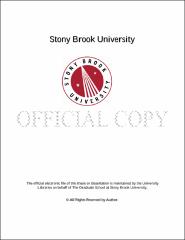| dc.identifier.uri | http://hdl.handle.net/11401/76667 | |
| dc.description.sponsorship | This work is sponsored by the Stony Brook University Graduate School in compliance with the requirements for completion of degree. | en_US |
| dc.format | Monograph | |
| dc.format.medium | Electronic Resource | en_US |
| dc.language.iso | en_US | |
| dc.publisher | The Graduate School, Stony Brook University: Stony Brook, NY. | |
| dc.type | Dissertation | |
| dcterms.abstract | High-bunch-charge photoemission electron-sources operating in a Continuous Wave (CW) mode can provide high peak current as well as the high average current which are required for many advanced applications of accelerators facilities, for example, electron coolers for hadron beams, electron-ion colliders, and Free-Electron Lasers (FELs). Superconducting Radio Frequency (SRF) has many advantages over other electron-injector technologies, especially when it is working in CW mode as it offers higher repetition rate. An 112 MHz SRF electron photo-injector (gun) was developed at Brookhaven National Laboratory (BNL) to produce high-brightness and high-bunch-charge bunches for electron cooling experiments. The gun utilizes a Quarter-Wave Resonator (QWR) geometry for a compact structure and improved electron beam dynamics. The detailed RF design of the cavity, fundamental coupler and cathode stalk are presented in this work. A GPU accelerated code was written to improve the speed of simulation of multipacting, an important hurdle the SRF structure has to overcome in various locations. The injector utilizes high Quantum Efficiency (QE) multi-alkali photocathodes (K2CsSb) for generating electrons. The cathode fabrication system and procedure are also included in the thesis. Beam dynamic simulation of the injector was done with the code ASTRA. To find the optimized parameters of the cavities and beam optics, the author wrote a genetic algorithm Python script to search for the best solution in this high-dimensional parameter space. The gun was successfully commissioned and produced world record bunch charge and average current in an SRF photo-injector. | |
| dcterms.available | 2017-09-20T16:50:55Z | |
| dcterms.contributor | Ben-Zvi, Ilan | en_US |
| dcterms.contributor | Verbaarschot, Jacobus | en_US |
| dcterms.contributor | Fernandez-Serra, Maria Victoria | en_US |
| dcterms.contributor | Wu, Qiong. | en_US |
| dcterms.creator | Xin, Tianmu | |
| dcterms.dateAccepted | 2017-09-20T16:50:55Z | |
| dcterms.dateSubmitted | 2017-09-20T16:50:55Z | |
| dcterms.description | Department of Physics | en_US |
| dcterms.extent | 98 pg. | en_US |
| dcterms.format | Monograph | |
| dcterms.format | Application/PDF | en_US |
| dcterms.identifier | http://hdl.handle.net/11401/76667 | |
| dcterms.issued | 2016-12-01 | |
| dcterms.language | en_US | |
| dcterms.provenance | Made available in DSpace on 2017-09-20T16:50:55Z (GMT). No. of bitstreams: 1
Xin_grad.sunysb_0771E_12755.pdf: 2272329 bytes, checksum: 51eb5ca2749f1fde67bc9b076c705a4a (MD5)
Previous issue date: 1 | en |
| dcterms.publisher | The Graduate School, Stony Brook University: Stony Brook, NY. | |
| dcterms.subject | Physics | |
| dcterms.title | Electron Source based on Superconducting RF | |
| dcterms.type | Dissertation | |

